Analyzing Drug Overdose Deaths
Abstract - Deaths from drug overdose including opioid overdose have been increasing at an alarming rate, and authorities still find tackling this problem an acute challenge. This paper applies Artificial Intelligence and statistical techniques to big data to identify the demographic and socio-economic factors that have led to the increasing number of drug overdose deaths in Allegheny County, Pennsylvania, United States. Using Artificial Intelligence software, we analyzed a dataset of over 3,500 patients alongside demographic and socio-economic variables to gain detailed insights into the issue, insights that we can generalize to craft solutions to this problem in both domestic and global communities. Our findings revealed patterns ranging from possible psychological and behavioral factors and drug use on weekends, a direct market supply effect on the number of deaths, age as a factor in most overdose incidences, the majority of the population are uninsured or unemployed, and live on the outskirts of Pittsburgh. These findings imply the need for authorities to offer educational workshops to individuals and their families about the dangers of the current drug epidemic and to design an effective policy for the oversight of drug market supply that includes taking firm action against violators. The research also showed that incidences of drug overdose by age is the least among Indian, but highest among White or African American people. The study further revealed that the habit and trend of drug consumption are very common among the White and African American communities, highlighting the need for healthcare dissertation help to address these critical issues effectively.
1. Introduction
Deaths caused by the opioid crisis have reached epidemic levels in the US, with more people dying from opioid overdose than by motor vehicle incidents, gun violence, or HIV [2]. In 2016, more than 42,000 Americans lost their lives as the result of a drug overdose, including 613 Allegheny County residents, a rise in deaths of over 44 percent. This has largely been attributed to the presence of newer, stronger drugs such as fentanyl in US communities [9]. Local health officials have found it difficult to keep pace with the new drugs being introduced into common usage, especially the presence of fentanyl in most of the heroin sold on the streets. Fentanyl is extremely potent and can cause a fatal overdose on the first try for some users [9]. Today, drug abuse is indeed a major problem in the US. A study by the Center for Disease Control (CDC) clearly evidences the existence of this crisis, stating that in 2017, more than 47,000 people died of a drug overdose in the country [8]. It was found that more than 2,000,000 Americans live with drug addiction, such as opioid addiction [9].
This study uses Artificial Intelligence (AI) and machine learning techniques to explore a dataset containing information on 3,551 fatal incidents of opioid overdose in Allegheny County, Pennsylvania, with the aim of finding ways to minimize the consequences of the opioid crisis in communities in the US and globally.
Opioid overdose has become an epidemic in the US as well as Allegheny County [9]. In 2015, the country experienced more than 400 deaths, and from then, the trend continued to increase. Data showed that individuals affected were within the age range of 25 to 54 years old. It was found that there are plenty of opportunities that have not been taken full advantage of in terms of intervention for opioid users [16]. The authors recommended that screening for opioid and other drugs among adults involved in child welfare should be improved. Further, enhancing the ability of the direct care staff to identify opioid use and risk of overdose, as well as access to expert consultants should be increased to improve the effectiveness of the care mechanism.

In Section 2 of this paper, we discuss and highlight different statistical tools and methods used to carry out the investigation to study several demographic factors of those affected in Allegheny County. While Section 3 focuses on providing a thorough analysis of the data collected through various sources, Section 4 highlights key findings of the study as well as trends in relation to the subject matter. Section 5 provides conclusion and recommendations pertaining to drug overdose in the community that can be used for prevention intervention. Drug overdose has continually exhibited an escalating trend in the US over the past years. From the year 1999 to 2017, an approximated number of 702, 000 persons perished from drug overdose. In the year 2017 alone, about 70,000 people succumbed to death following drug overdose, making drug overdose one of the biggest cause of injury-related deaths in the US (Rhodes et al., 2019). Out of these deaths, about 68% encompassed illicit opioid or prescription. The United States Department of Health and Human Services (HHS) is determined to addressing the challenges revolving around overdose, dependence and opioid and has developed five-point concrete strategy to address these issues namely; better pain management, better data, better pain management, treatment and recovery services, increased production of overdose reversers, and informed research. Based on this determination, various agencies within Health and Human Services (HHS) have joined the effort. This study intends to discover how consumptions of opioids and consequential deaths caused by the same are distributed amongst different demography, using Artificial Intelligence tools.
2. Methodology
To gain greater insight into the social and economic factors that have increased the risk of fatal opioid overdose in Allegheny County, PA, we used multiple approaches utilizing AI and statistical software and programming languages, including IBM SPSS Analytics, IBM Watson Analytics, Microsoft Power BI, Python, and IBM Cognos Analytics to explore the dataset, which contained information on 3,551 fatal incidents of opioid overdose in Allegheny County.
The dataset, which covers opioid overdose deaths from the year 2008 to 2017, includes fatal accidental overdoses in the country and contains information on the date of death, the time of death, the manner of death, the age, gender, and race of the decedent, the seven most prevalent drugs found in overdose victims, the zip code of the overdose incident, and the zip code of the decedent’s residence [1]. To look further into this issue, we searched for other variables that may have a relationship with opioid overdose rates. These other variables can be divided into two general categories: climate and economic.
The climate variables we examined were monthly average temperature and temperature departure from mean levels for the 2008-2017 base periods. This data was retrieved using the National Oceanic and Atmospheric Administration “Climate at a Glance” tool [3]. However, there were no findings that revealed a correlation between temperature and drug overdose, thus, these graphs were eliminated from the study.
The economic indicators we examined were county unemployment rate and income inequality in the county (measured as a ratio of the mean income of the highest quintile of earners divided by the mean income of the lowest quintile of earners in the county). These two datasets were collected from the FRED Economic Data service of the St. Louis Federal Reserve Bank. The final variable examined in this category was the uninsured rate, data on which was sourced using the U.S. Census Bureau’s Small Area Health Insurance Estimates program [15].
3. Analysis
It has proven valuable to first observe the overdose dataset by itself to get a full understanding of the situation and to provide a baseline against which to compare the climate and economic variables examined.
The timespan of this dataset is from 01/03/08 to 12/31/17, a total of 9 years, 11 months and 28 days. The most surprising and saddening takeaway from the data is the age range of those affected by fatal drug overdose, which is an astonishing 1 to 91. The n for this dataset is 3,460.
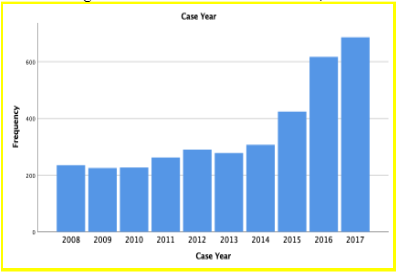
Figure 1 indicates overdose deaths over the past several years have been increasing at an exponential rate. This cannot be explained simply by an increase in population as the population of Allegheny County has fluctuated over the past decade and has, in fact, not grown at all. The graph uses data from 2010 (the earliest year in which reliable data was collected) to 2017, to illustrate the rising trend in overdose deaths.
Across all ten years covered by the dataset, it becomes clear that the crisis appears to have two distinct peaks in terms of age: one among those in their 20s and 30s and another among those in their 50s. The most common age for someone in the county to die of an overdose is 51, indicating that there is a slight skew toward the older of the two age peaks. Moreover, the standard deviation is 12.5, showing that most deaths occur within an approximately 24-year timeframe in mid-life.
It is interesting to observe how age distribution across drug overdose deaths changes over time. The double peaks are not initially pronounced, but develop over time until 2017, when they seem to disappear. It is also interesting to see how age range widens over the years as well, and how age distribution starts to skew toward younger people. Nonetheless, the opioid epidemic is more prevalent among men than women given that women accounted for a comparably low 31 percent of fatal drug overdoses in this timeframe.
It is also clear that the overdose deaths in this county occur overwhelmingly among White Americans. However, it is worth looking at the demographics of the county overall to identify any major disparities. In Table 1, we compare overdose deaths with county population data that closely aligns with U.S. Census data. While there may be some disparities in the total percentages due to non-matching categories, for the purposes of a “sanity check” on the proportions of overdose deaths in the dataset, the table serves its purpose.
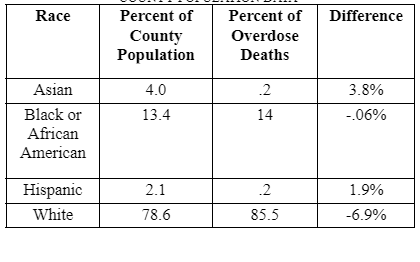
It appears that Asian and Hispanic ethnic groups are comparatively less affected by overdose deaths to a small degree and African Americans are more affected, again by a small amount. Meanwhile, White American are overrepresented as victims of overdose deaths by a larger difference than any other, although still not by a significant degree.
It is interesting to note that April and August are the most common months for overdose deaths to occur. The reasons for this are not obvious and warrant further investigation. However, other than August, there is a decline in deaths during the summer months, which may suggest a possible seasonal element in overdose deaths.
Figure 2 shows the number of deaths by day of the week, the results collected here are perhaps unsurprising. Friday, Saturday, and Sunday see the highest number of overdose deaths. People are less likely to be working on these days and will thus have more leisure time. These days are also when people are most social, which, depending on the person, can involve alcohol or recreational drug use.
The spike in overdose deaths that occurs at around 5 pm is also of interest. This is when many people get out of work and there may be a connection here. The fact that most overdose deaths occur in the middle of the day is interesting as well, particularly the spike observed at 1 pm.
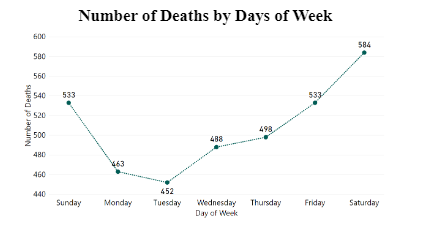
Frequency
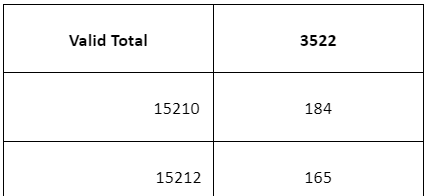

Figure 3 shows the top five zip codes for the locations of overdose deaths in the county during the period examined. They account for a substantial proportion of all overdose deaths, but overall distribution remains quite wide and dispersed.
Frequency
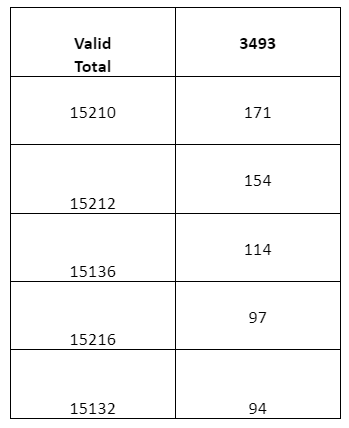
Figure 4 shows the top five zip codes for the residences of people who suffered a fatal drug overdose in Allegheny County during the period examined. They are the same as the zip codes identified as the top five locations of fatal overdoses. This overlap indicates that people tend to overdose in the zip code in which they live, which seems reasonable. Nonetheless, there are some differences in frequency and a far larger range of zip codes cover the residences of the decedents. So, some people do travel and then overdose, including from as far away as West Virginia and even Minnesota.
Geographical Distribution of Uninsured Persons

Figure 5 shows that most uninsured people live on the outskirts of Pittsburgh. The reason behind this could be so that they can easily avoid the law and thus ensure that they do not get caught buying and consuming drugs. In addition, since these areas are situated near the border, getting access to different types of opioid drugs and other such substances becomes simpler and easier for them. The dark blue color highlights the number of uninsured people. Herein it may also be said that majority of these individuals, living an uninsured life on the outskirts of Pittsburgh are also unemployed. They prefer living in this region, so that they do not have to perform any job, and so that they can gain easy access to drugs and other substances. A study released in 2017 on the lessons on the opioid epidemic states that misuse and use disorders were most common among those who were uninsured or unemployed, were low-income individuals, or had behavioral health problems [7].
4. Findings and Trends
This section highlights key findings of the study, as well as trends in relation to the subject matter as per the demographic variables tested.
A. Gender and Race in Allegheny County and Overdose Deaths
Figure 6 analyzes the distribution between male and female in overdose deaths in Allegheny County. The study revalidates that overdose deaths are more amongst men, which make up around 69 percent of the total deaths. Women account for 31 percent of the total deaths.

Figure 7 identifies the number of deaths by race. It is seen that White Americans represent the highest segment of the population that is affected among drug users and number of fatalities due to the opioid crisis.
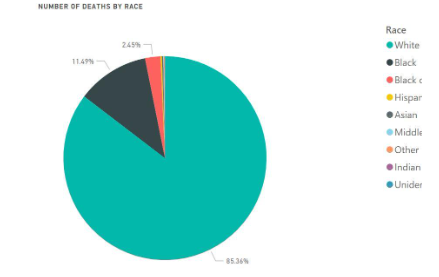
Drug Overdose by Age & Race Distribution

Figure 8 shows that incidences of drug overdose by age is the least among Asians, but highest among White American and African American people. The average age of these individuals is 45 years. On this basis, it can be said that 45 years old White or Black Americans who live in Allegheny County are high-risk individuals for drug overdose, and even though Allegheny County is a developed region, there are a considerable number of people who still are taking excessive amounts of drugs. Similarly, the average age of Middle Eastern people is also 40 years. Cases of drug overdose among the Middle Eastern people is considerably high, and it is also considered one of the major markets for drug consumption. From the above information it can also be observed that these individuals start taking drugs from a very young age.
Race Distribution by Unemployment Rate

Race Distribution by Uninsured Rate

Figures 9 and 10 show how the drug overdose death rate is influenced by the uninsured rate and unemployment. From the above images, it can be observed that the uninsured and unemployment rate is considerably high among White Americans. This resulted in a significant increase in the death rate. At the highest level of uninsured rate, i.e. 10%, the number of deaths was very low. However, at the lowest uninsured rate, the rate of unemployment is very high. On this basis, it can be said that there is a direct relationship between uninsured and unemployment rate. Unemployed individuals are not able to afford to insure themselves. This creates a significant gap in the number of people who have an insurance cover and the ones who do not.
B. Month to Month Fluctuations
Looking at every year separately on IBM Watson, a cloud system for data analytics, another pattern emerges whereby months with abnormally high death counts are followed by months with abnormally low death counts, and vice versa. This may be related to the availability of drugs in the market, reflecting the high level of addiction to drugs containing fentanyl and heroin specifically. The authorities have successfully taken down various platforms that were previously used to sell and buy drugs, but not a lot of information has been gathered in terms of the effects of such an action [4].
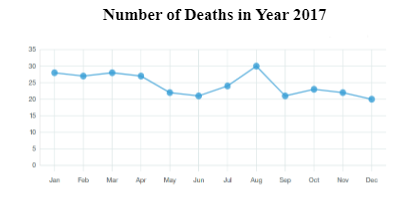
In 2017, the aforementioned pattern was most visible in the months of August and September. August saw a high number of deaths and was followed by September, a month with lower deaths, which is the pattern we recognized through IBM Watson which we concluded that this could be related to market supply. When one particular month has a high death number, the following month is much lower, suggesting that the supply is lower in the market. The year ended with relatively low death rates in comparison with previous months.
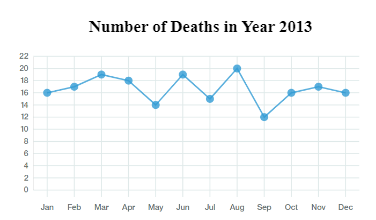
As per the visualization in Figure 12, the year 2013 is a very good example of the potential oscillating trend, in which months with very high fatal drug overdose rates are followed by months with significantly lower overdose death rates.

Looking at all the years examined together in Figure 13, we can confirm the pattern that shows that it may be due to the supply of drugs in the market, which causes fluctuation in deaths by months. Looking at August, for example, we see a peak in deaths, of which then September shows much lower deaths. As previously mentioned, this was also apparent when we studied each year separately on IBM Watson. There was a high indication that after a month of high deaths, the following month sees much lower deaths. The visualization in Figure 13 was generated using Microsoft Power BI.
Consumption of Drug Category OD1 by Race
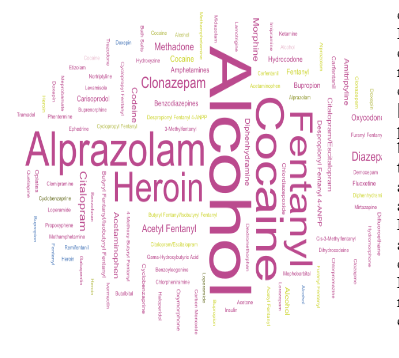
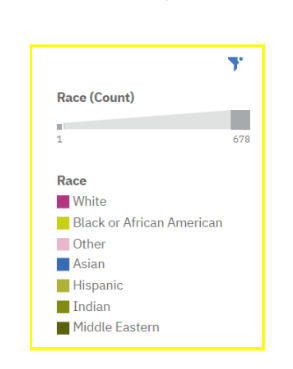
Figure 14 shows the consumption of one of the drug categories which was tested as part of the data analysis, and labeled as OD1, OD which stands for overdose, and had listed the names of the drugs which the patient consumed. We tested the drug names by race consumption. In the above image, which is a word cloud generated from IBM Cognos Analytics, it can be noted that White American people consume the most amounts of drugs. A word cloud is a technology to visualize language or text data, which has recently gained increasing attention and more application opportunities in big data analysis [6]. It includes the likes of Fentanyl, Heroin, Alprazolam, Alcohol, Cocaine, and many more. A recent study confirms that Fentanyl-related overdose is on the rise nationwide and is a particularly pressing problem in the eastern part of the United States. The eastern U.S. heroin market consists largely of white powder heroin, which is easier to cut with fentanyl due to its color and consistency compared to western black tar heroin. In addition, Fentanyl is easier to produce than heroin, and can be smuggled in small batches, and offers high profit margins for sellers. Thus, these characteristics have contributed to its increased prevalence in U.S. drug markets [11]. Consuming drug has almost become a common practice among White people. Due to this reason, it may not be wrong to say that these individuals are the most exposed to different health-related issues and deaths due to drug addiction and abuse. Consuming drug is also fairly common among people from Black or African American race. However, on the other hand, Asian people consume the least amount of OD1 drugs, as seen in the figure above. Similarly, consuming OD1 drugs is almost non-existent in Indian, Middle Eastern people. People from other races that were not included in the current study also consumed the OD1 drug in a significant number.
Consumption of Drug Category OD2 by Race


Figure 15 shows the consumption of OD2, another category which was listed and labeled for drug names, and has been leveraged through IBM Cognos Analytics to analyze drug name by race, to reveal whether there is a pattern that is recognized. Herein it can be observed that although White Americans do not consume OD2 drugs as they consume OD1 drugs, the drugs they intake are considered among the most lethal drugs. Due to this reason, they are most exposed to deaths and other health issues from OD2 drugs. The pattern of consuming drugs such as Heroin, Cocaine, and others among White American people is increasing at a very fast pace. There are more individuals consuming such drugs than people from any other of the races. However, similar to the consumption pattern for OD1 drugs, individuals from other races, not included in the current study, also consume a wide variety of OD2 drugs, which puts their life at great risks.
Furthermore, more people from Black or African American community consume OD2 drugs as opposed to OD1 drugs. On this basis, it can be observed that different races have developed different preferences for the drugs that they aim at consuming. This is weakening these communities and is putting their lives in danger. Consumption of OD2 category drugs in Asian, Indian and Middle Eastern people is again very low.
5. Conclusion and Recommendations
This data analytics study provides an expanded exploration of the problem of opioid drug overdoses in Allegheny County. Applying several statistical techniques, including pattern recognition, and generating other data visualizations, we were able to validate previously identified findings about overdose deaths, such as the age range and general demographics of affected populations [5][16]. We found the tools we used to be very useful in helping us to gain a better understanding of our sample set and to generate informative and understandable visuals.
Data Analytics also allowed us to find new information about our sample, particularly when combined with the additional variables added to the base dataset. We were able to generate highly practical visuals and illustrate clear trends from a large dataset with many variables, indicating that there is a possible relationship between drug addiction and lower temperatures and between psychological and behavioral factors and weekend drug use as well as a direct market supply effect on the number of deaths. These findings imply the need for authorities to offer educational workshops to individuals and their families, as well as health practitioners, about the dangers of the current drug epidemic and to design an effective policy for the oversight of drug market supply that includes taking firm action against violators.
From the above analysis, it can be concluded that majority of the people, who are uninsured and unemployed, live on the outskirts of Pittsburgh so that they can get easy access to drugs. The study further revealed that the habit and trend of drug consumption are very common among Black or African American people. The average age of such individuals is 45 years meaning that they continue to consume drugs for a considerable period of their lives. During the study it was further noted that that uninsured rate has a direct relation with the rate of unemployment. This means that most of the unemployed people tend to avoid taking an insurance cover for the fear of paying money that they are not earning. In addition, they know that drug consumption will result in them being unable to take full advantage of their insurance cover if they had one.
We recommend that the authorities spend more time and funds on advertisements to educate individuals and families about the problem as well as investing in approaches to oversee market supply to drug users. Creation of awareness is one of the most comprehensive approaches to sensitize communities concerning the consequences of opioid overdoses, but also one of the avenues to equip dependents, addicts and the general public with knowledge, skills and correct attitudes towards opioid-free and dependence-free lifestyles. The relevant governmental departments such as the Human and Health Services and other relevant institutions should vest time and resources in the creation of awareness to induce more information to the general public about the negative impacts associated with drug dependencies and also provide necessary information which can guarantee abstinence from opioid overdoses. The awareness will extend further to create an understanding about how to efficiently deal with opioid use disorder and how to deal with it effectively and comprehensively.
Besides creation of awareness, this study also recommends community empowerment programs to keep the vulnerable groups (especially the youths) occupied and attached to meaningful economic and social constructs, to help them deviate away from indulgence in opioid reliance and from engaging in other malpractices. Such empowerment programs should be tailored to alleviate laxity amongst the youths in an urbanized setting, to deviate their attention ways from any engagements in substance abuse. By so doing, this will yield more multiplier effects such as employment creation, reduced deaths and increased productivity within the existing population.

The third and last recommendation is to consider sending the victims of opioid dependence to rehabilitation centers to permanently ensure individuals undergoing detoxification do not relapse back into opioids. Opioids may rewire the brain, inducing forth substantial cravings which may trigger irresistible urges to fall back and use these drugs. The role of the rehabilitation centers will be geared to ensure persons are keenly guided and monitored towards permanent emancipation from the wants and chains of opioids and related effects.
The issue of drug overdose deaths is so pressing that more research by data and population scientists is needed to gain further insight into this epidemic, so that impactful solutions can be found to reduce its harmful effects on communities both in the United States and around the globe. This study cognizes a limited study in the field of drug overdose, especially pertaining to the causes leading to overdoses. There is need for a more systematic review and primary studies unraveling this important field which is otherwise claiming the lives of the most productive ages in a population. More study in this field will provide useful insights to policy makers, planners and the government on the way forward.
Results of the current study supported results of the past studies. Thus, the limitation of this research was that there were no new findings obtained. The tools used in this study helped in enabling us to recognize patterns through data visualizations, and we encourage future researchers to leverage the use of multi-dimensional data to find factors that could possibly correlate to the drug addiction epidemic to explore new findings within regional and global communities. It is the hope that this information will be used in enhancing understanding of readers regarding the subject matter.
References
D. Ciccarone, “Fentanyl in the US heroin supply: a rapidly changing risk environment”, The International journal on drug policy, vol. 46, pp. 107-111, 2017.
B. R. Edlin, “Access to treatment for hepatitis C virus infection: Time to put patients first”, The Lancet Infectious Diseases, vol. 16(9). doi:10.1016/s1473-3099(16)30005-6, 2016.
Jin, Y. Development of word cloud generator software based on python. Procedia Engineering, 174, 788-792, 2017.
Rhodes, B., Costenbader, B., Wilson, L., Hershow, R., Carroll, J., Zule, W., ... & Brinkley-Rubinstein, L. Urban, individuals of color are impacted by fentanyl-contaminated heroin. International Journal of Drug Policy, 73, 1-6, 2019
B. Saloner, “A public health strategy for the opioid crisis”, Public Health Reports, vol. 133, pp. 24S-34S, 2018.
Take a deeper dive into Analysis of Professional Staff Organization with our additional resources.
- 24/7 Customer Support
- 100% Customer Satisfaction
- No Privacy Violation
- Quick Services
- Subject Experts



